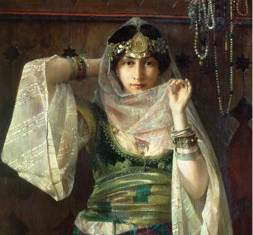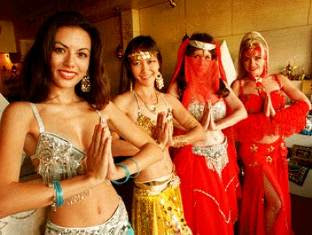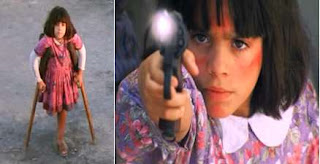Arabface! The History of Racist Arab Stereotypes
Arabface!
Introduction
Arabface refers to the creation and propagation of racist Arab stereotypes and caricatures. The word Arab is primarily used to describe people from the Middle East. Despite the fact that the Middle East is comprised of different countries, with diverse cultures, beliefs and a variety of religions, the people are often characterized by one term, "Arabs." Many people think that all Arabs are Muslims and all Muslims are Arabs but the truth is that there are millions of Arabs who are not Muslims and millions of Muslims who are not Arabs. Iranians, for instance, are Persians, not Arabs. They do not speak Arabic, nor do they have Semitic origins. For many Americans the word Arab is convenient shorthand that references a relatively small number of stereotypical images.
Racist Arab Stereotypes
For centuries the Arab has played the role of villain, seducer, hustler and thief -- the barbarian lurking at the gates of civilization. In the late 20th Century new images emerged: the fanatical terrorist and the suicide bomber. Arabs have become the all-purpose villains or buffoons across all American media, including books, films, television, and computer games.
The Sheik
The Sheik has long flowing robes, a beard, sunglasses, pockets stuffed with petrodollars, and he drives a giant SUV.
The Bedouin
The Bedouin is a nomad who treks the desert sands on a camel and sleeps in a tent.
The Terrorist
The Terrorist is a mad
dog who is happy to sacrifice his life to kill women and children, and
because he'll get 79 virgins in heaven.
The Maiden
The Maiden is a beautiful princess who wears a veil, is waited on my numerous female attendants and is guarded by eunuchs.
The Burka
The Burka is a robe
with only a mesh opening for the eyes. Arab women have to dress this way
so they don't excite men who cannot control their sexual urges if they
see a wrist or an ankle.
The Arab Street
Angry people who take to the streets shouting "Death to America" while shaking their fists and beating themselves with chains.
The Haggler
All sellers in the
market are hagglers who ask outrageous prices for their goods, but they
will cut their prices to the bone in the face of any resistance. In
Appointment With Death (1988) Lauren Bacall says, Arabs "have a nose for
bargaining."
The Bellydancer
Belly dancers dance provocatively and are sexually available.
This proliferation of negative ethnic stereotypes is damaging to society in many ways, but the stereotypes can be especially harmful to children who aren't also being exposed to positive ethnic images.
Arabface in Film and TV
Hollywood has consistently stereotyped Arabs since the earliest films, but filmmakers did not create the stereotypes, they inherited and embellished Europe's pre-existing Arab caricatures. Thomas Edison made a short film in 1897 in which "Arab" women in harem outfits dance to seduce a male audience. The short clip was called Fatima Dances and was the first film to use the belly dancer stereotype. French filmmaker Georges Méliès produced several films in the early 1900s that made use of existing Arab stereotypes; dancing harem maidens, fat potentates, bearded camel-jockeys, and palace eunuchs.
American media has evolved to depict a more balanced view of most cultures, but Arab stereotypes remain one-dimensional. Hollywood has always relied on stereotypical depictions of "bad guys" and after the fall of the Soviet Union, Arabs became the bad guys of choice in American action films. It's not surprising that so many people think of Arabs only as terrorists and murderers because of how the media usually presents them. Some in the Arab American community call this the three B syndrome: Arabs in TV and movies are portrayed as either bombers, belly dancers, or billionaires.
Planet of The Arabs is a montage of Hollywood's relentless vilification and dehumanization of Arabs and Muslims. Inspired by the book "Reel Bad Arabs" by Dr. Jack Shaheen
Negative portraits of Arabs are found in numerous popular films, such as Raiders of the Lost Ark (1981), Back to the Future (1985), and True Lies (1994). While producers, executives and others in entertainment industry deny perpetuating stereotypes, negative attitudes towards Arabs are self-evident in the depictions. Until the media makes greater use of positive aspects of Arab culture and peoples within normal everyday contexts negative stereotypes will continue to be the dominant images.
A good example of cartoons depicting Arabs in a negative manner is the Disney animated feature film, Aladdin (1993). In its attempts to make the film more appealing to the Western world, Disney Americanized the names and appearances of the lead characters. The film's light-skinned lead characters, Aladdin and Jasmine, have Anglicized features and Anglo-American accents while most of the other characters are dark-skinned, swarthy and villainous, with Arabic accents and grotesque facial features.
Disney is by no means the only offender. Arab stereotypes are a staple of Saturday morning TV cartoons that depict Arab women as belly dancers and harem girls, and Arab men as marauding tribesmen, violent terrorists, and oil sheiks.
Scores of comedies have presented Arabs as buffoons. Many popular stars have mocked Arabs: Laurel and Hardy in Beau Hunks (1931); Bob Hope and Bing Crosby in Road to Morocco (1942); the Marx Brothers in A Night in Casablanca (1946); Abbott and Costello in Abbott and Costello in the Foreign Legion (1950); the Bowery Boys in Bowery to Baghdad (1955); Phil Silvers in Follow that Camel (1967) Marty Feldman in The Last Remake of Beau Geste (1977); Dustin Hoffman and Warren Beatty in Ishtar (1987).
Arabs trying to abduct, rape, and or kill fair skinned Western maidens has been another very popular theme that dates to the earliest days of filmmaking. In Captured by Bedouins (1912) marauding tribesmen kidnap a Western girl, try to seduce her, and then demand a ransom for her return. Their plans are thwarted when the girl's British officer fiance sneaks into their camp and rescues her.
Several films with the same theme were popular in the 1980s; desert sheikhs abducting and threatening to rape Western maidens; Brook Shields in Sahara (1983), Goldie Hawn in Protocol (1984), Bo Derek in Bolero (1984), and Kim Basinger in Never Say Never Again (1986).
Israeli Film producers Menachem Golan and Yoram Globus bought the American film company Cannon Films in the 1980s and produced a string of 26 virulent anti-Arab films like Hell Squad (1985), Invasion USA (1985), The Delta Force (1986), Delta Force II (1986), and Killing Streets (1991). These films pioneered the stereotype of Arab terrorists in action films and most of the Arabs were played as broad caricatures by Israeli actors in "Arabface."
In Executive Decision (1996) terrorists hijack a Boeing 747, en-route to Washington, DC. They beat and kill innocent people, including a flight attendant and a US Senator while demanding the release of a terrorist leader who was previously captured by US authorities. But after the leader is released it is revealed that the actual mission is to blow-up Washington DC and contaminate the entire Eastern Seaboard of the USA with a nerve gas that was hidden aboard the aircraft. When one terrorist objects to the new mission as something that Allah would not approve of, he is promptly killed by the terrorist leader.
In The Siege (1998) New York City is terrorized by a series of bombings carried out by a fifth column of Arab-American blue collar workers and students. They detonate a bomb in a Federal Building, a crowded theater, and a city bus. These actions cause the imposition of martial law and widespread violations of the civil rights of Arab-Americans. The abuses ignite a backlash of protests from the Arab-Americans that other terrorists seek to exploit by bombing their own people in the midst of a protest. The terrorists' plan to cause and exploit divisions among Americans is foiled, but in many ways the film itself serves the same ends by sowing fear and suspicion along racial lines.
In Rules of Engagement (2000) producers broke new ground in American cinema by attempting to justify the slaughter of children. The film slowly reveals details that bring viewers to the point where the machine-gunning of a crowd of Arab demonstrators outside of an American embassy seems reasonable because the American commanding officer believed some in the crowd were firing at his soldiers. When the smoke clears, 83 civilians lie dead and 100 have been wounded, including many women and children, but no weapons are ever found. After an international outcry, the commanding officer is charged with the murder of innocent civilians.
Rules of Engagement
Innocent victim -- or terrorist?
Rules of Engagement first elicits our sympathy for a young girl who has been crippled when American soldiers fired on Arab civilians. But a later flashback from the point of view of the Colonel who is on trial for ordering the troops to fire on the civilians shows the same girl along with other men, women and children firing weapons. Is the flashback an accurate representation of what actually happened or just the way the Colonel remembers it because he is on trial for murder? The film never answers that question, but the court vindicates the Colonel.
The rules of engagement for American soldiers say that if a civilian of any age points a weapon at them they are allowed to kill that person in self-defense. However the film raises some very important questions that were never even considered; what if a small number of people with guns fire from within a much larger crowd that is unarmed? Is it reasonable to mow down the entire crowd to kill a few gunmen? The film seems to be saying that it's OK as long as the innocent civilians are Arabs. How many innocent Arab civilians can be sacrificed for each "terrorist?" The film seems to be saying as many as necessary. Would the answers to those questions be different if the innocent civilians being used as human shields were Americans instead of Arabs?
Millions of innocent civilians have been killed in the Middle East since 9/11 and many of these deaths have been excused as unavoidable collateral damage by American political and military leaders. If American intelligence believes a wanted terrorist is hiding in a residential area, they have no problem with launching a missile strike that takes out a few civilians in order to get one bad guy. The American people -- if they hear about the deaths at all -- don't care how many Arab civilians become collateral damage in the "war on terror" and this attitude is the inevitable result of the long history of dehumanizing stereotypes of Arabs in American media.
The Social and Cultural Implications of Arabface
Explore the History of other
Racial and Racist Stereotypes in the Media
Please visit our partners:
Buy * Will Write for Food * T-shirts
Kachina.us - Guide to Hopi Kachina Dolls
Agile Writer -- Biography and History













Comments
Post a Comment